Note: This website was automatically translated, so some terms or nuances may not be completely accurate.
[Children's Perspective Lab] To understand the mysterious creature known as "children," we tried becoming babies.
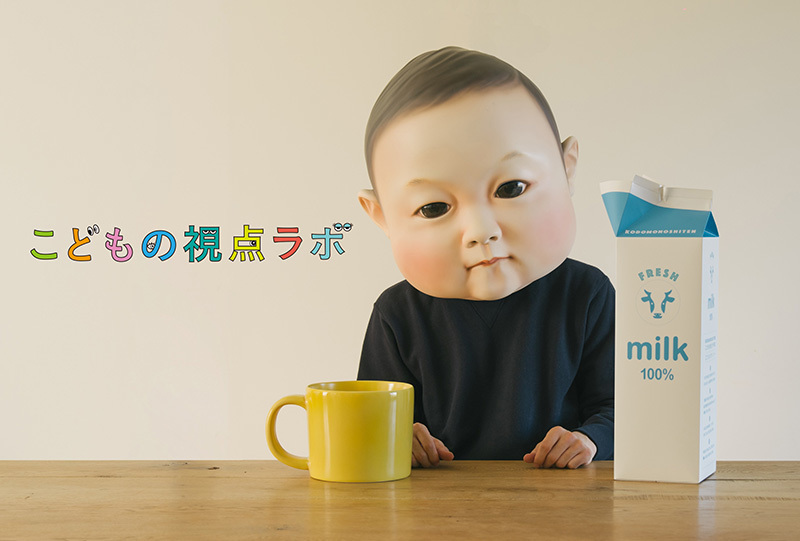
"Mommy, your face is big. I'm two years old now, so when I get even bigger, my face will be as big as Mommy's, right?"
This was a comment from my son, who was two at the time. For a moment, I thought he was dissing me for having a big face, but that wasn't it.
"Doesn't this mean the child now possesses the concepts of 'past' and 'future'?"
He understood that after turning one, he became two, and that two meant there was a future beyond that.
"Until yesterday, there was only the present moment..." I was surprised and deeply moved, and at the same time, I suddenly realized. How many times had I forced statements like "Snack time is later, later" or "The park is tomorrow" on a creature that only knew the present moment?
I always talk big when making ads, saying things like "from the consumer's perspective" or "putting myself in the target's shoes," yet as a parent, I never even tried to understand how my toddler felt or what was going on inside their little brain.
"No, it's not too late. I want to know."
If I could understand my child from their perspective, wouldn't I force less on them? Wouldn't I avoid getting irritated or angry with them? Couldn't society and children have a better relationship?
So, together with Kutsukake Mitsuhiro, a dad and AD who spends his days intently observing the wonders of his 0-year-old child, wondering "How does this kid see me?" and "I hear babies' vision is different from adults'," we launched the "Child's Perspective Lab" to see the world as a child.
It's a lab where we seriously yet enjoyably research what it truly means to see things from a child's perspective. But since babies and toddlers can't participate in group interviews, we have to become children ourselves, experience things firsthand, and research by asking, "Isn't it like this?" So, our very first research project is this.
What if adults became babies' heads?
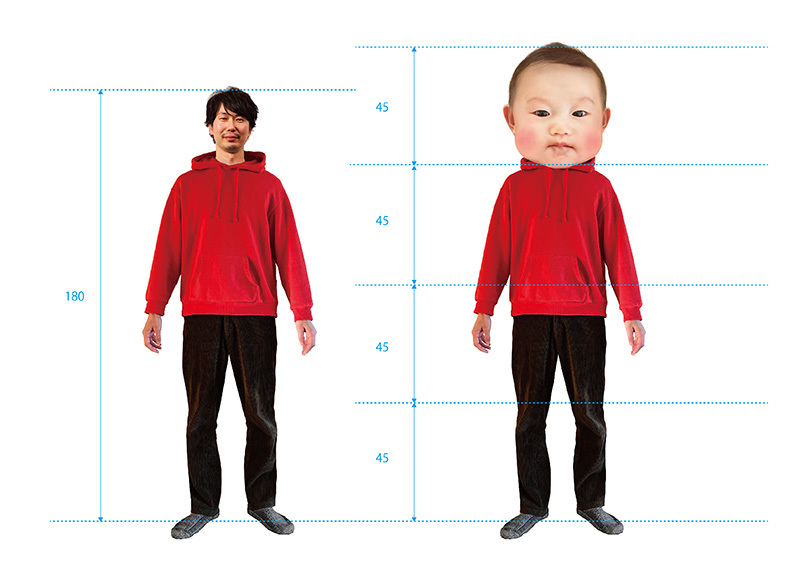
We decided to create a "Baby Head" that lets adults experience a baby's head. Newborns are said to have a head-to-body ratio of about 4:1, with the head weighing roughly 30% of their total body weight (※1). If we scale that to a 180cm tall, 70kg man,
"a head length of 45 cm and a weight of a whopping 21 kg"
. Our model is Kutsukake-kun's son, Haruta-kun.

With the cooperation of Dentsu Live Inc. and Kukan Geijutsu Sha, the "Baby Head" is steadily taking shape. Initially resembling an old man with a baby face, adjustments to eye size and cheek color have made it look more like Haruta-kun. Trying it on, it's quite heavy. Making it any heavier would probably make your neck snap... It was decided that recreating the full weight was too dangerous and should be avoided.
Visiting the University of Tokyo Baby Lab with the Baby Head
With the completed Baby Head in hand, we visited Professor Kazuo Kai of the University of Tokyo's Baby Lab, whom we had previously consulted about the "Child's Perspective Lab." Professor Kai is a leading expert in infant studies. He uses the preference-based gaze method (※2) to analyze babies' preferences and has created best-selling picture books like 'Moi Moi' and 'Urushii' that truly delight infants. Picture books made from a child's perspective!
※2 = Preferential Looking Method
A method that measures which item a subject looks at the longest when given multiple choices.
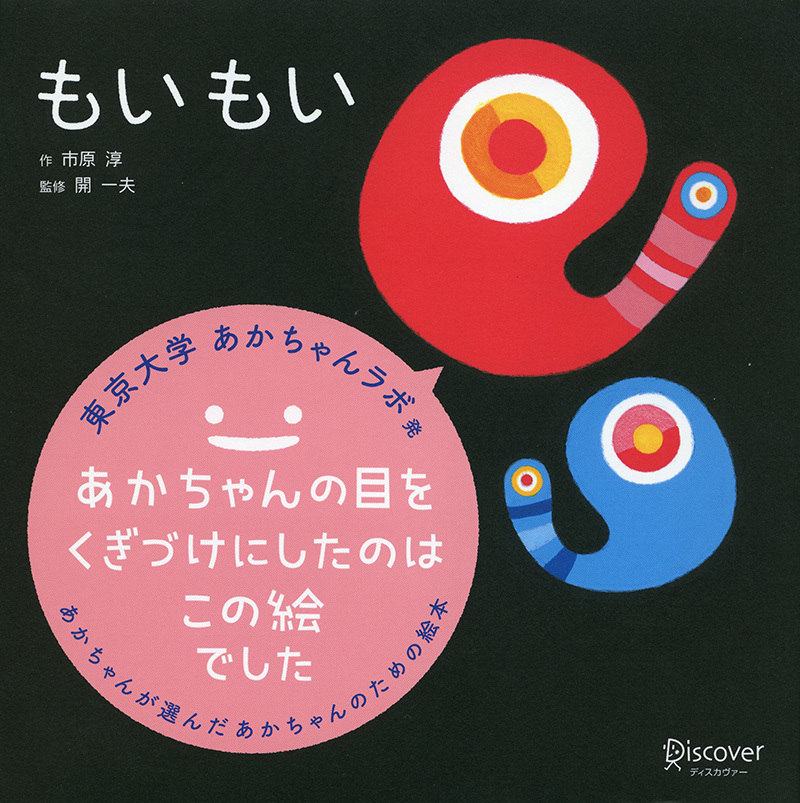

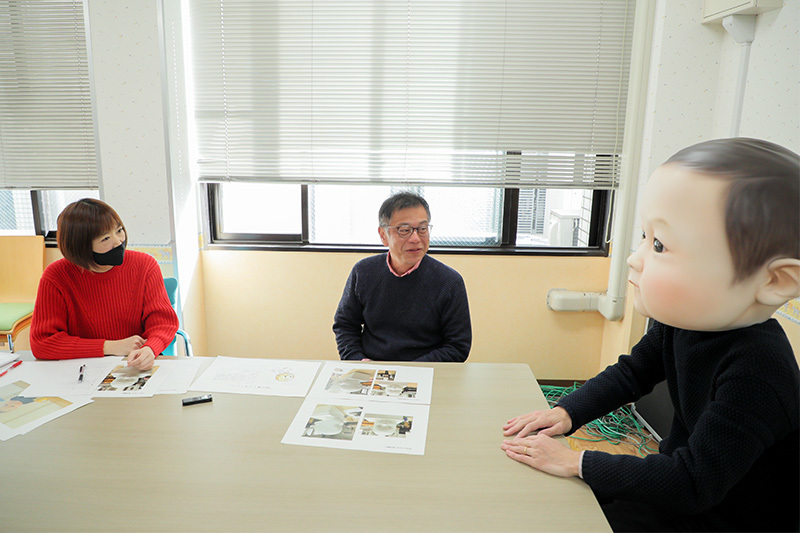
Ishida: Teacher, I made a baby head.
Professor Kai (hereafter, Professor): W-Wow, that's scary. The face is cute though. It's so big. Can I try it on?
Ishida: Wow, you're actually going to try it yourself, Professor!

Professor: It's heavy~ How many kilograms is this?
Kutsukake: Currently, it's 1.5 kg. Calculations show it should be 21 kg, but that would be too dangerous to wear.
Teacher: This is incredible. It makes you understand those sad news stories about kids leaning out from balconies and falling. Keeping your balance with this is really tough. I realized it for the first time myself. You might understand it intellectually, but putting it on yourself is seriously heavy. Calculated at 21kg?
Ishida: Yes. My son just turned six, and he weighs exactly 21 kg right now. To think it's like carrying a six-year-old on your head all day... it's unbelievable...
Professor: Wow, that's incredible (laughs). It really shows how amazing it is for a baby to roll over, stand up, and develop neck control with a head like that. It requires an incredible sense of balance.
Ishida: I read in your book that a baby's brain is about one-seventh of their total body weight (※3). Is that because humans are just that heavy?
Professor: I think monkeys and whales also have heavy brains, but in terms of body weight ratio—or relative to their own body size—the human brain is exceptionally heavy.
※3 Source: 'The Wonders of Babies' (by Kazuo Kai / Iwanami Shinsho)
Ishida: Why do babies even come out with such big heads?
Professor: This is actually considered a small size. Humans walk upright, so our birth canal is narrower than other animals'. That's why the baby comes out while the head is still small and underdeveloped, to fit through.
Ishida: So they're born significantly premature compared to other animals?
Doctor: That's right. If they were born as developed as zebras or deer, which can stand immediately after birth, they wouldn't fit through the birth canal. By emerging small and underdeveloped, they encounter the outside world and their parents earlier than other animals, receiving stimulation. They can learn. That's
"what makes us human."
, and I agree.

Kutsukake: I've heard that at birth, a baby's vision isn't as developed as their touch or hearing.
Doctor: Hmm. While hearing develops in the womb, I don't think it's fully adult-like. Touch develops relatively early, I think. They can touch themselves and learn inside the womb. With recent 4D ultrasounds, you can even see them sucking their thumb in there. Sucking on a thumb isn't something you can do without knowing how your own body is structured, right? It's not just randomly grabbing a finger that happens to be there. They bring their hand to their mouth, and before that, they open their mouth to prepare. I think they learn by trying various things like that inside the womb.
Visual information, on the other hand, is fundamentally different from the outside world. The amount of light is different, and they don't know where to look. In that sense, it's true that they're born without having trained their vision.
Kutsukake: I see~ That's fascinating.
Ishida: Changing the subject, there's something I've wanted to ask you for a while. Your lab conducted an experiment showing "babies prefer heroes," right?
Professor: Yes. We created an animation featuring characters like a bully, a victim, a hero who stops the bullying, and bystanders who don't intervene. We then studied how babies reacted to the hero and the bystanders. What we found was that most babies showed a preference for the hero.

Ishida: After conducting the experiment, did you really sense morality in the babies?
Professor: Well, you can't exactly look at a baby and say, "This one looks like it wants to beat up the bad guy" (laughs).
If we could just ask them, "Which one do you like? Which one is the bad guy?" we wouldn't need experiments. It's precisely because we can't ask that it's interesting. That's why our experiments—measuring brain activity and tracking what they look at longer—are meaningful.
But experiments like this tend to yield similar results regardless of who conducts them. It's hard to explain why, but if a group was full of mean people, they couldn't function together. So it's possible that aspect is genetically hardwired. No matter where you go in the world, you find people helping each other. I don't think there's any culture where people just fight all the time. Of course, there are often situations where one group is hostile toward another. But if there were a people who just fought constantly within their own group, that culture would collapse, right?
Ishida: That's true. It's really deep, isn't it?
Babies are born full of mysteries—perhaps they're already born loving justice. From this research and interview:
● A baby's head is incredibly heavy—far heavier than adults imagine. We should keep this in mind while supporting their daily safety.
● Humans are born significantly premature compared to other animals. They develop their "human-ness" in the outside world while training various senses.
● Rather than just providing care, I want to think of the baby period as a crucial time for nurturing "human-ness."
That's what I learned.
Looking back on my own child's baby period, I wonder if things like talking to them constantly from right after birth (even if they showed no reaction) or making a snowman right in front of them while freezing, letting them touch it (even if they seemed to dislike it), might have had meaning in nurturing that "human-ness"?
I thought, surely the most important thing is for them to see the people around them getting along happily, to feel loved, and to get the sense that "this world seems like a pretty good place after all."

Ishida: By the way, Professor, I have one more thing I'd like to show you here.
Kutsukake: It's the cup and milk I mentioned before when we discussed "What if adults became the palm of a two-year-old's hand?"
Teacher: Oh, you made it! Whoa, it's this big? (laughs)
(Continued in "Trying to Pour Milk as a Two-Year-Old")
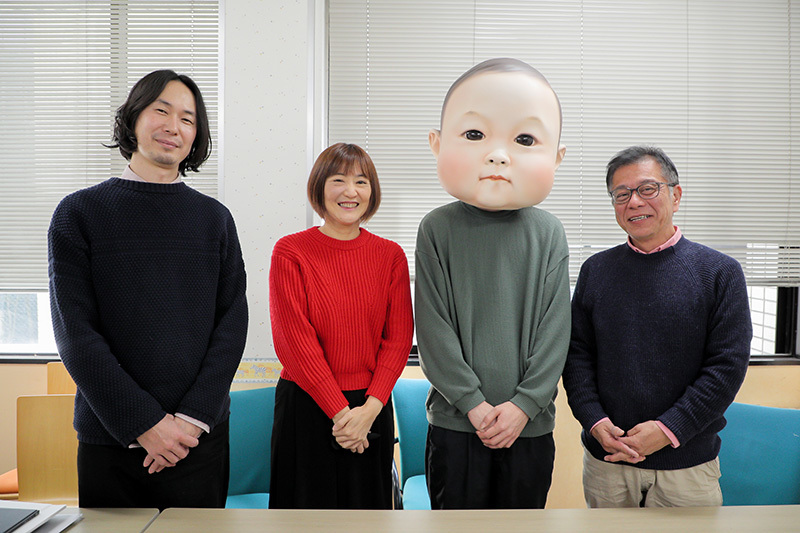
Was this article helpful?